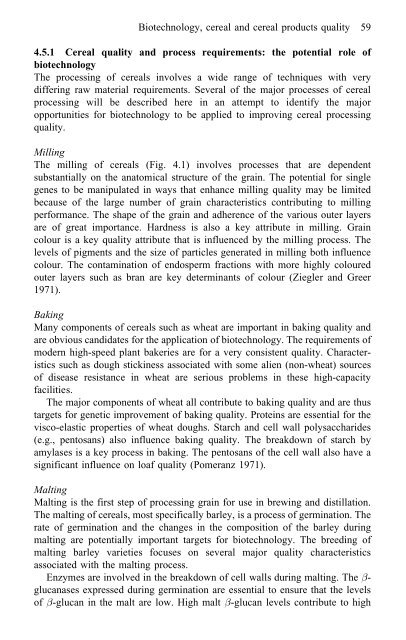Cereals processing technology
Cereals processing technology
Cereals processing technology
You also want an ePaper? Increase the reach of your titles
YUMPU automatically turns print PDFs into web optimized ePapers that Google loves.
Bio<strong>technology</strong>, cereal and cereal products quality 59<br />
4.5.1 Cereal quality and process requirements: the potential role of<br />
bio<strong>technology</strong><br />
The <strong>processing</strong> of cereals involves a wide range of techniques with very<br />
differing raw material requirements. Several of the major processes of cereal<br />
<strong>processing</strong> will be described here in an attempt to identify the major<br />
opportunities for bio<strong>technology</strong> to be applied to improving cereal <strong>processing</strong><br />
quality.<br />
Milling<br />
The milling of cereals (Fig. 4.1) involves processes that are dependent<br />
substantially on the anatomical structure of the grain. The potential for single<br />
genes to be manipulated in ways that enhance milling quality may be limited<br />
because of the large number of grain characteristics contributing to milling<br />
performance. The shape of the grain and adherence of the various outer layers<br />
are of great importance. Hardness is also a key attribute in milling. Grain<br />
colour is a key quality attribute that is influenced by the milling process. The<br />
levels of pigments and the size of particles generated in milling both influence<br />
colour. The contamination of endosperm fractions with more highly coloured<br />
outer layers such as bran are key determinants of colour (Ziegler and Greer<br />
1971).<br />
Baking<br />
Many components of cereals such as wheat are important in baking quality and<br />
are obvious candidates for the application of bio<strong>technology</strong>. The requirements of<br />
modern high-speed plant bakeries are for a very consistent quality. Characteristics<br />
such as dough stickiness associated with some alien (non-wheat) sources<br />
of disease resistance in wheat are serious problems in these high-capacity<br />
facilities.<br />
The major components of wheat all contribute to baking quality and are thus<br />
targets for genetic improvement of baking quality. Proteins are essential for the<br />
visco-elastic properties of wheat doughs. Starch and cell wall polysaccharides<br />
(e.g., pentosans) also influence baking quality. The breakdown of starch by<br />
amylases is a key process in baking. The pentosans of the cell wall also have a<br />
significant influence on loaf quality (Pomeranz 1971).<br />
Malting<br />
Malting is the first step of <strong>processing</strong> grain for use in brewing and distillation.<br />
The malting of cereals, most specifically barley, is a process of germination. The<br />
rate of germination and the changes in the composition of the barley during<br />
malting are potentially important targets for bio<strong>technology</strong>. The breeding of<br />
malting barley varieties focuses on several major quality characteristics<br />
associated with the malting process.<br />
Enzymes are involved in the breakdown of cell walls during malting. The -<br />
glucanases expressed during germination are essential to ensure that the levels<br />
of -glucan in the malt are low. High malt -glucan levels contribute to high



